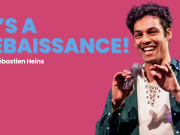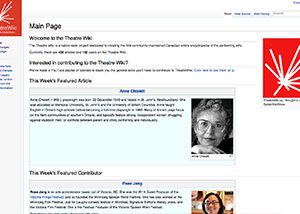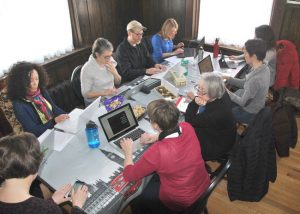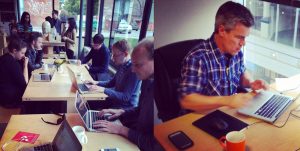Territories
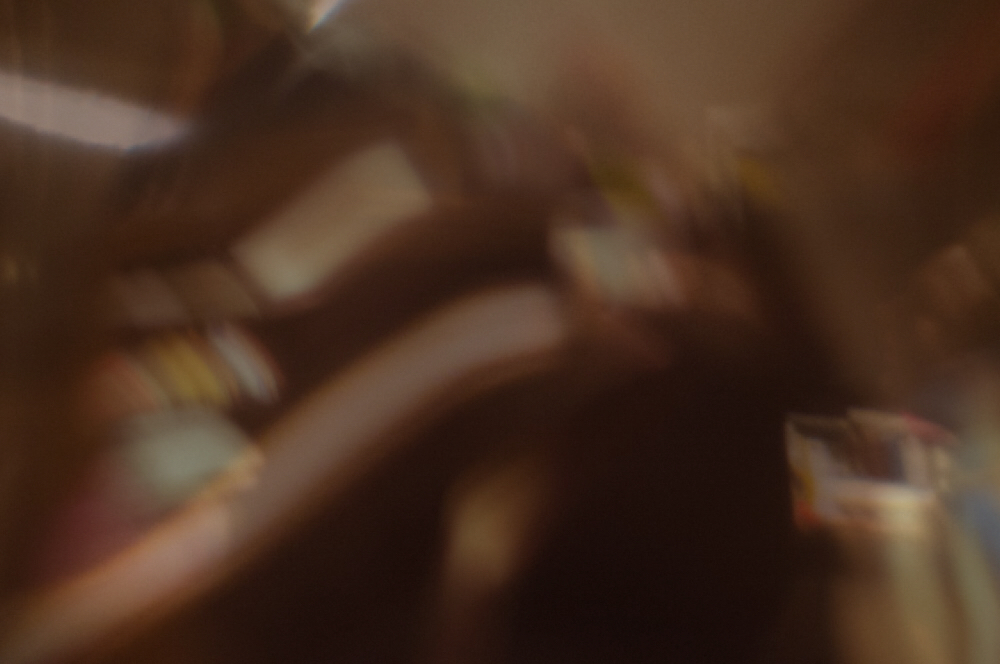
Play: Territories || Playwright: Niki Landau
Shoot: Pointe St Charles|| Model: Olivier Bouyssou, Evelyne Desjardins
SARA: You know, I think you’re right. Peace is overrated. It’s like marriage. All the negociations, all the compromises. You ask yourself, is it worth it? To have to smile when you want to spit. To cut your dick off, just so the other person doesn’t feel threatened. To lie, and lie, and say everything’s alright, when the truth is you’re dying, your soul is dying because all of those fucking compromises and you realize that you’ve traded freedom to just buy a little stability. And there’s nothing stable about it, is there? It could fall apart at any time, and then it’s like nothing ever happened. You’re back to square one, only dickless. No thanks. I’m with you. Fuck peace. I want a divorce.
Territories premiered in November 2005 at Theatre Passe Muraille in Toronto.
Owning the Means of Cultural Production
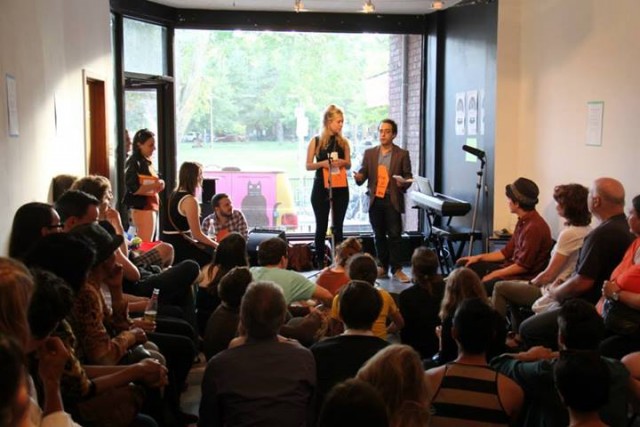
The most 2014 thing I did in 2014 was Twitter-view Monologist Mike Daisey using #DaiseyTO – while sitting across from him at the same Dark Horse Café.
Having written about Daisey and his ideas about independent art creation on praxistheatre.com several times, it was a great opportunity to take a discussion about how the North American theatre ecology has evolved to an increasingly influential Twittersphere. The most salient piece of advice he had was:
+ 100 MT @mdaisey: .@sommerau Make your own shit. Always. Own the means of production. Always. Every theater maker must know this. #DaiseyTO
— Michael Wheeler (@michaelcwheeler) May 20, 2014
Since this twitterview, it has been a busy time during which I became Executive Director and Transformation Designer of Small Theatre Administrative Facility, which is in the midst of large-scale changes. (Also it seems Daisey has quit all social media, with even his website becoming private.)
At STAF, We announced what these would be in a broad sense through a letter to the community this November, and the aim is to maximize the impact the organization can have on independent theatre by shifting from a fees-for-services model to a capacity-building organization for the sector. The letter lays out the structural factors underlying these changes, but the point made by Daisey above crystallizes philosophically what this transformation represents:
Currently, independent theatre favours entrepreneurial self-producing artists who own the means of production. I like this language because it is clear, concise, and I think an accurate reflection of the zeitgeist. It also defuses a major tension in this discussion between neoliberal arguments for culture as an economic driver and quality of life arguments as well as more esoteric rhetoric about art, life and meaning.
We can all agree that artists are being more entrepreneurial and this is a good thing.
For profit-conscious advocates, theatre artists are finally accepting their role in a market-based economy. Meanwhile those of us that are skeptical of restricting art to what is profitable (or profitable for real estate) can understand the entrepreneurial shift as a way to throw off some of the chains that have kept cultural production in the hands of a well-insulated elite.
Owning the means of production in theatre is an extremely difficult proposition however. Mirvish-fare aside – theatre in Toronto can’t pay its costs through earned revenue. Even a (very rare) sold out box office doesn’t usually generate a living wage for the artists involved, without other contributions through grants or donations. In fact, a question being asked right now is, “Can we all just admit there is no such thing as nonprofit sustainability?”
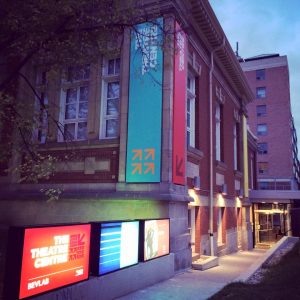
So there is a certain amount of ‘green-lighting’ that has to happen by peers and/or those with money before you can mount work that achieves professional standards. So “owning” the means of production in this context is a tricky proposition – and the question of what is “professional” becomes even more muddied.
This is the situation we now find ourselves faced with adapting to at STAF. As an indie theatre artist running an organization dedicated to improving the capacity of independent theatre artists, it is my hope we can make this shift in a manner consistent with open source philosophies:
We hope to maintain a high degree of transparency, seek collaboration and feedback, and make the results of our work available to the community. The first step in this open source transformation is an Open Source Feedback session taking place at Theatre Centre on January 26 from 630 – 930PM, (which will likely continue more informally across the street at The Dog and Bear afterwards).
It will begin with what we know: Here’s our situation, here’s what we do and don’t plan so far. Then we will break into moderated groups that require brainstorming and discussion to generate new ideas and genuine feedback about what indie theatre artists need to succeed in 2015. A summary of these results will be available on our website shortly after the event which we will livetweet, and I’m hoping we hear ideas we haven’t even thought of yet.
This is not to say we don’t have some very specific notions about what we can do moving forwards. I’m excited to announce some of these plans in our initial presentation at the session. Yet there are some Big Ticket Items not yet resolved. These run the gamut from: “Should we provide co-working Hot Desks?” to “What should the new name of the organization be?”
97,100 cultural workers in TO = 7.2% of labour force. ON artists median income $23,200, 41% < workers in ON. http://t.co/7eTaR2C7MX #cdncult — Michael Wheeler (@michaelcwheeler) January 4, 2015
There is a big shift underway in how theatre is created. There is an even bigger shift needed in how it is produced and supported.
We exist as theatre creators at a moment where the infrastructure is adapting much slower than the art and artists are. Faced with the choice of lamenting a system resistant to change or inventing a new one, lets choose the latter. Looking forwards to beginning to take control of the means of cultural production in 2015.
If you are interested in coming to the open source feedback session –shoot us an email to info@theatreadmin.com or tweet @STAF_TO.
Green Room
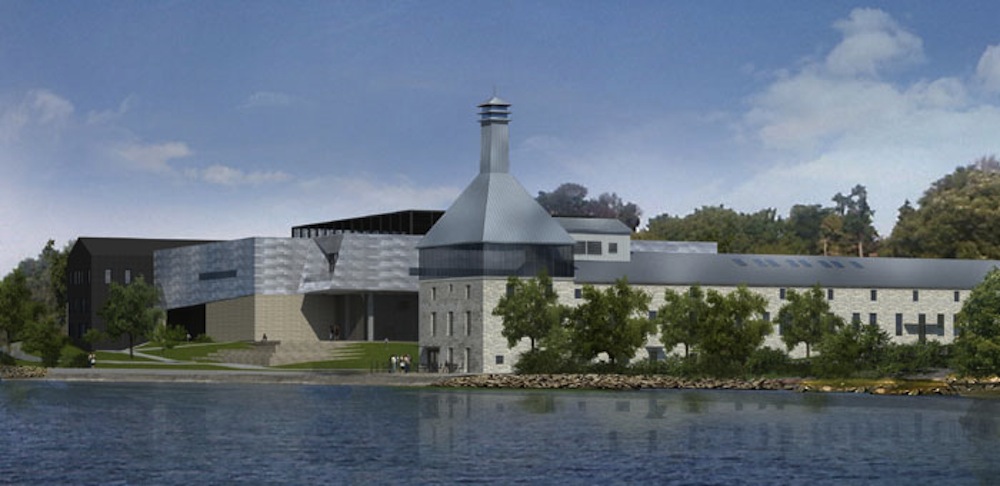
When I left theatre school, I was one of the lucky ones (yes, lucky) that landed a job almost immediately.
You may remember me? I played guard #2 in Sarah Phillips’ adaptation of Antigone…
The production was full of theatre names like Michael Healey, Richard Greenblatt, Christine Brubaker, etc. and, despite my incredibly small part/talent/experience, they welcomed me into Canadian Theatre with open arms. They made me feel a part of It. And because I felt a part of It, I listened and I learned, I respected and I risked. It was the beginning of my life as a theatre maker. That feeling was further expanded by our rehearsal location. We spent long days in one of the rehearsal rooms upstairs at Tarragon breaking to the central green room when we were lunching, coffee-ing, or simply when we weren’t ‘on stage’. Which, for guard #2, was a lot. In that green room sat various and sundry theatre folk who were also working on assorted shows in the adjoining rehearsal halls doing what we did, hanging out. It was here that I met a handful of my theatre heroes, listened to stories, asked questions, and heard about their wins and losses in Canadian Theatre.
Green rooms have always held a certain fascination for me – so few theatres that I have worked in spend any resource making them comfortable, exciting, or inviting. Yet so many of us have spent countless hours staring at the same yellowing promotional posters, lining up at the microwave and furtively pouring coffee that we haven’t paid for (yet). The green room is the living room of Canadian Theatre. And also it’s kitchen. And, well, the dining room as well. It is where we live when we’re not ‘out there’. A private place for us to commune in repose. And it is a place where theatre makers can inspire and be inspired.
Fifteen years and umpteen green rooms later, I have found myself in Kingston, ON firmly clenching the bannerpole for professional artistry and for Canadian Theatre. There are only a few us ‘old’ pros here but the place is lousy with emergent talent. It brims with excitement, creativity, and promise.
When the City of Kingston announced that it would be turning a rambling waterfront heritage building into an arts cluster facility, I jumped at the chance for Canadian Theatre to play a role. Since then, it has taken five years and a significant investment from the City but they have finally achieved what they sought out to do: The Tett Centre for Creativity & Learning provides subsidized space to 8 anchor arts organizations of which my company, Theatre Kingston, is one. It also houses 8 studios for resident artists, a gallery space, workroom, a rehearsal hall and an event space. It is an incredible feat for a community of this size and a testament to the municipal government’s commitment to arts & culture.
When Theatre Kingston was allotted 1500 square feet to dream with, I immediately knew what we should do. It was time to put together my own space where I could give young artists what had been given to me at the Tarragon those many years ago. Opening officially this Spring, the TK space will house three individual offices for three companies (one of which is ours), a joint office with three desks that will be made available on short term leases for smaller companies that need a base of operations for a production, and The Lounge. The Lounge is really a reincarnated version of my experience at the Tarragon. It is intended as a geographical manifestation of the amorphous concept “Canadian Theatre community”. Or “It”. It is my gift to this region’s pulsating emergent theatre people – a place where they can create, coordinate, and communicate. Not to mention rub shoulders with the various professional theatre artists that we bring in from out of town. Y’know – the ones with the stories about their wins and losses?
Physically, the space will have several significant features: a 14-seat table for meetings and readings, a cork wall for audition/classes/production announcements, a bunch of couches/chairs for lounging, and a 2500-play ‘take one, leave one’ dramatic literature library for use by the community. Ideologically, it is an epicenter for mentorship and support to the next generation of theatre artists that will come out of this region. The Lounge will host readings, socials, outings, and masterclasses focusing on ‘Hometown Heroes’ like Randy Hughson, Sue Edworthy, Maev Beaty, Judith Thompson, Chilina Kennedy and many more that have come from Kingston and who will be invited home to share their experiences with the current crop of ‘recruits’. It will be a green room. But the coffee will be free.
An Adolescent Growth Spurt
The 2014 edition of the PuSh marked the 10th anniversary of the Festival. We’ve been growing steadily, but the past year has seen as much growth and change as ever in our history.
On December 15, 2014 we moved to a new facility located at 110-750 Hamilton St in the core of downtown Vancouver right beside the CBC. Within 100 metres of our office is the central branch of the Vancouver Public Library as well as two main civic venues, the Queen Elizabeth Theatre and The Playhouse.
The new space is a 8,477 square foot cultural arts hub that reflects a movement towards shared platforms that’s been happening in Vancouver in recent years, Progress Lab being the best known across the country as an example. In our case, we’re moving in with organizations from other disciplines.
The idea for a co-located facility had been in the works for years, but the process of moving into this particular space began in October 2013. Minna Schendlinger, PuSh’s first managing director was at the helm of the project in the beginning (and continues on now as facility manager) with Roxanne Duncan stepping in as our new managing director in the midst.
A photo posted by @j_rosario on
There are so many metaphors to explain the past year at PuSh and all this change. My favourite at the moment is the adolescent growth spurt. We’re like that nephew or niece you haven’t seen in a year who’s suddenly grown almost as tall as you. Our ankles are showing beneath our now too-short trousers, it’s happened so quickly there hasn’t been time to buy new ones. Not to worry though, we’ve got a brand new outfit right in time for the 2015 Festival.
About half of the facility is office space for each of the organizations along with shared meeting room and amenity spaces. The other half is dedicated to community use, housing two spaces bespoke to the specifications of multidisciplinary tenants, and will soon be available for rentals of many different uses: sprung floor and grand piano for rehearsals and practicing (Thanks Touchstone! Thanks Music on Main!), large wall-mounted television for screening videos (Thanks DOXA!), just to name a few.
I know that each organization has given great thought to the long-term impact of the new space, both individually and collectively. With the timing of PuSh right after the holidays it means that we hit the ground sprinting right out of the gate. Right now, I’m focused on the immediate and practical benefits of the space, which can only be fully appreciated if you had the opportunity to be in our former 850 square foot office space (which I fondly referred to as ‘the festival sweatshop’).
Here’s what a day in the curatorial department at PuSh looks like.
A photo posted by @j_rosario on
We can now do an open concept office the right way. There’s much debate about the effectiveness of open floor plans, try surveying the opinions of any baby boomer vs Gen Xer vs millennial working at the new Canada Council offices in Ottawa. PuSh’s artistic and executive director, Norman Armour, has been a staunch advocate of open floor plans for years – it fosters not just more openness and collaboration but porousness between departments, and now between organizations, which is reflected in the architectural design of the office spaces.
We each have our own bullpens; distinct, dedicated spaces with walls between but no doors separating. In the middle are shared meeting spaces with glass walls in order to preserve as much natural light as possible (we’ve basically retro-fit a 1970’s built space). The meeting rooms have been designed to accommodate quiet spaces for solo-working, one-on-one meetings, as well as staff meetings within and between our organizations. It’s plenty of space for the confluence of ideas and dialogue, as well as to get away when the hive-mind gets to be too much.
For PuSh as a Festival, we now have physical space, a home of our own, to invite more interaction with our audiences and guests during the Festival. It’s as simple as the ability to have a place where pass holders can meet with audience services staff in person, where visiting artists and presenters can be welcomed and pick up materials without being in the middle of a bullpen.
It’s been many years since I’ve had a downtown commute to work. One of those times is when I worked at an office at the Scotiabank Dance Centre, a 32,000 square a shared use facility for the dance community built in 2001. The impact of increased space and infrastructure to support artistic production (in this case, contemporary dance) has been immense, and I’m sure different and greater than what was envisioned at the outset. There is a thriving contemporary dance scene here and some of the most talked-about dance in the country is coming out of Vancouver.
Occupying physical space in a public and civic sense as well as making a home – placemaking, to be au courant – was part of making that happen. I could make the same parallel between Progress Lab’s history and impact, how the companies that make that scene are regarded nationally, and now their new collaborative venture.
From my view in the curatorial department, I’m looking forward to devising new ways for us to interact with our peers, audience and new neighbours. PuSh takes place in 20 days, but it takes at least that many months in the planning. There are so many conversations that I’d like to continue and people that I didn’t get a chance to meet. There are so many discussions that need to start before, happen more widely and continue after the Festival.
Moving some of our PuSh Assembly events and inviting folks to ‘our house’ will be a great test run to see how the space works. We’ll also be hosting an artist-in-residence during the festival for the second year, but this time with workspace at 750 Hamilton attached. Often, a festival’s engagement with an artist is limited to a specific presentation – the artist comes to town, performs and then leaves again. I’m excited to extend an invitation that allows for more interaction, not only with PuSh but also with the city itself and its artistic community.
If you’re in town, come by for a visit. PuSh has the pleasure of soft-opening the space during the upcoming Festival. Stay tuned for an official opening with our housemates later this Spring.
#CdnCult Times; Volume 4, Edition 7
PuSh plots a move to less-cramped quarters in 2015.
Welcome to 2015. After many years of ‘snopesed’ FB posts exposing hoax images implying this is the year of the hoverboard from Back to The Future, we can finally revel in incredulity. We have arrived at an era that will unsurprisingly not meet the collective expectations shaped by 1980s Hollywood films.
But there is good news: There are many new and exciting developments in Canadian theatre that did not involve Michael J Fox and this edition highlights three: Two new homes for theatrical creation in Kingston and Vancouver and a new home for indie creators in TO. The future’s so bright we’ve gotta wear shades?
Michael Wheeler
Editor-in-Chief: #CdnCult Times
World Theatre Day Edit-a-Thon
Friday, March 27th
We are live! Click here to participate in the World Theatre Day Edit-A-Thon!
@ Edit Sites Across Canada – click here to find the edit site nearest you!
Join us from between 12pm – 4pm at edit sites across Canada (or from the comfort of your own home) as we spend World Theatre Day writing and editing articles that celebrate the multiplicity of voices Canadian theatre has to offer.
The Theatre Wiki is a nation-wide project dedicated to creating the first community-maintained Canadian online encyclopedia of the performing arts.
With over 458 articles and 192 active users, the Theatre Wiki continues to grow by leaps and bounds.
Past Edit-A-Thons
Sunday, March 8th, 2015: Equity in Theatre Hosts a Hackathon
In celebration of International Women’s Day, Equity in Theatre partnered with theatre companies and organizations from across Canada launched an edit-a-thon dedicated to rectifying the significant lack of articles on Canadian women in theatre online. Over the course of 24 hours, 185 new articles were written on female theatre practitioners, with 138 unique visitors visiting the site.
Saturday, November 15th, 2014: The Theatre Wiki Is Launched
On Saturday, November 15th, 2014, users gathered at locations across Canada to launch the Theatre Wiki, Canada’s first online community-based encyclopedia. In three hours, participants from 30 cities wrote 150 articles.
For a list of the cities and venues that participated, click here.

